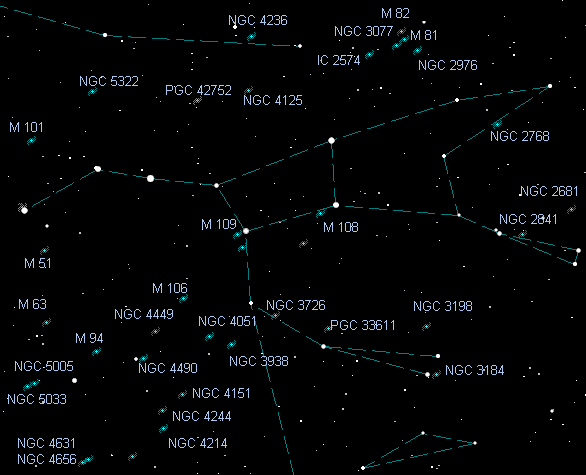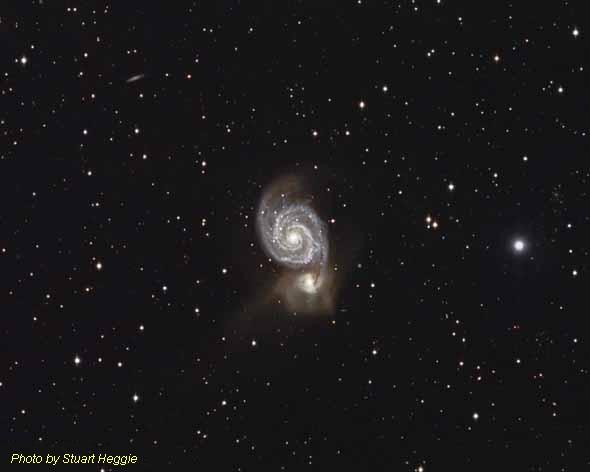The Bear and the Dog
With spring now upon us, nature is joyfully coming out of hibernation. Warmer weather settles in as animals such as the bear awaken from their winter slumber. Just like its shaggy hair cousin, the great celestial bear is up and about in northern skies. Even though it is circumpolar meaning it never sets, the Big Dipper in nicely overhead all night long.
Mighty Ursa Majoris is the third-largest in area and is well-placed overhead with its seven prominent stars taking on the form of a kitchen pot or a farmer’s plough (in the United Kingdom). Other than the constellation of Orion The Hunter, Ursa Major is the most recognizable constellation in the heavens.

The suns that make up Ursa Major are located from 78 to 123 light-years from us. These stars are slowly moving through space but not all in the same direction. In fact, the Dipper shape can be only 50,000 years ago. As time goes on, the pointer star – Dubhe will move to the front of the group. A great test for sky transparency is to visually split the double star or Alcor (the small rider) and Mizar (the horse) with the naked eye.
Within the confines of the constellations of Ursa Major, Canes Venatici, Coma Berenices and ending at Virgo, many bright Messier and NGC objects are at your disposal. This month we will look at the first two constellations. For example, M106 is a lovely spiral galaxy with bright knots. At magnitude 8.3, it is one of the brightest galactic examples of Messier’s collection. M106 is about 25 million light-years away.

What night wouldn’t be complete without visiting M51 dubbed the Whirlpool Galaxy? I use this magnitude 8.4 face-on structure as a guide to sky transparency. What appears to be a connection to M51 the galaxy NGC 5195 is merely a line of sight object and not physically connected. At 37 million light-years away, a large scope will still show good detail in M51’s pancake of stars and nebulae.
NGC 4051 is another semi face-on galaxy located an estimated 54 million light-years in space. At almost 11th magnitude, most scopes should pick it up from dark locations away from light pollution. The greatest view of two galaxies in the same low power field of view has to go to M81 and M82. Both glow at about 8.5 magnitude and reside 12 million light-years and 11 million light-years respectively.
M109 is a third of a degree from the bright second magnitude star named Phecda – the lower left star of the Dipper’s bowl. To view this 55 million light-years elongated galaxy you will have to keep the star out of the field of view. It is a bit of a challenge as the galaxy is 11th magnitude. Keeping on the lines of elongated galaxies, we have NGC 5033. It possesses very long but faint wispy arms with a bright core. This 37 million light-years object is considered a Seyfert galaxy as it has a few candidates located in the nucleus which vary in brightness.
Before leaving the great bear, you must stop by the Pinwheel Galaxy. Catalogued as M101, this galaxy reveals its majestic arm structure in large scopes and photos. This 27 million light-year galaxy also goes by NGC 5457 and has other NGC numbers assigned to its knotty arms.
Our three brightest planets are still putting on a great show. Venus is unmistakable as it hangs high in the western sky. It will reach great eastern elongation (45 degrees) on June 9th. On April 14th Venus will scoot under the Pleiades by two degrees. Saturn will be a show stopper this spring during star parties and sidewalk astronomy sessions. Five moons of Saturn are visible any given night and the rings are as majestic as ever. The yellowish ringed planet moved into the constellation Leo in late August of last year and is very high in the night sky after sunset. The King of planets – Jupiter is p in the South East just after 1:00 a.m. locally at the beginning of the month. Large tides are expected on April 17th as the New Moon will also be at its closest to the Earth for the month at 357,136km.
The Lyrid meteor shower will best be seen after midnight when the crescent moon is gone on the mornings of April 22nd and 23rd. Although rated at a low 10 to 20 meteors seen per hour per single observer, half that rate should be more realistic as this year’s shower is variable. Lyrid meteors are typically faint and fast. Head out of the city and look for an area with a clear horizon and all directions. But don’t blink, you might miss one.
Astronomy Week commences on Monday the 16th with the world celebrating International Astronomy Day on the 21st. Here in Canada many RASC Centres and astronomy clubs will take their passion to the public in the form of mall and museum displays as well as public star parties where weather permits. This is a great time to speak to astronomers about the night sky and telescopes.
NASA will soon decide the next launch date of the Space Shuttle Atlantis and its mission to continue work on the International Space Station. The delay gives engineers more time to assess the damage from a late February hail storm when Atlantis was on the launch pad ready for a mid-March assent to space. Golf ball size hail left hundreds of dents in the external tank’s foam insulation. Stay tuned for updates. And when the Shuttle is given the OK, follow the mission on NASA TV on the web with your favourite media player.
Many satellite sightings are visible throughout the night. These (moving stars) can be operational satellites or spent stages from old rockets. An excellent web site to get a time table for your area is Heavens Above. Simply choose your city or town from the huge database and you can even follow the International Space Station. We will continue our tour of galaxies next month.
Clear skies everyone
Gary Boyle
| Object | Type | Magnitude | RA | DEC |
|---|---|---|---|---|
| IC 2574 | Elongated galaxy | 10.0 | 10h 28m | 68d 23m |
| M 101 | Spiral galaxy bright knots | 7.7 | 14h 03m | 54d 19m |
| M 106 | Spiral galaxy structure with bright knots | 8.3 | 12h 19m | 47d 15m |
| M 108 | Very elongated galaxy, dust & bright knots | 10.1 | 11h 11m | 55d 37m |
| M 109 | Elongated galaxy with a bright core | 11.0 | 11h 58m | 53d 20m |
| M 51 | Spiral galaxy structure attached companion | 8.4 | 13h 30m | 47d 10m |
| M 63 | Elongated galaxy with a bright core | 8.6 | 13h 16m | 42d 00m |
| M 81 | Spiral galaxy | 6.9 | 09h 56m | 69d 02m |
| M 82 | Elongated galaxy, dust & bright knots | 8.4 | 09h 56m | 69d 39m |
| M 94 | Elongated galaxy with a bright core | 8.2 | 12h 51m | 41d 05m |
| NGC 2681 | Round galaxy bright core | 10.3 | 08h 53m | 51d 17m |
| NGC 2768 | Elongated galaxy | 10.0 | 09h 14m | 76d 27m |
| NGC 2841 | Elongated galaxy dusty | 9.3 | 09h 22m | 50d 56m |
| NGC 2976 | Elongated galaxy dusty | 10.2 | 09h 47m | 67d 53m |
| NGC 3077 | Elongated galaxy | .9.9 | 10h 03m | 68d 42m |
| NGC 3184 | Round galaxy | 9.8 | 10h 18m | 41d 23m |
| NGC 3198 | Very elongated galaxy | 10.4 | 10h 20m | 45d 31m |
| NGC 3726 | Elongated galaxy dusty | 10.4 | 11h 33m | 46d 59m |
| NGC 3938 | Round galaxy | 10.4 | 11h 53m | 44d 04m |
| NGC 4051 | Spiral galaxy | 10.3 | 12h 03m | 44d 29m |
| NGC 4125 | Elongated galaxy | 9.8 | 12h 08m | 65d 08m |
| NGC 4151 | Round galaxy bright core | 10.4 | 12h 10m | 39d 21m |
| NGC 4214 | Spiral galaxy | 9.7 | 12h 15m | 36d 17m |
| NGC 4236 | Very elongated galaxy | 9.7 | 12h 16m | 69d 25m |
| NGC 4244 | Edge on galaxy | 10.2 | 12h 17m | 37d 46m |
| NGC 4449 | El galaxy bright core | 9.4 | 12h 28m | 44d 03m |
| NGC 4490 | Spiral galaxy w/companion | 9.8 | 12h 30m | 41d 35m |
| NGC 4631 | Elongated galaxy, dust & bright knots | 9.3 | 12h 42m | 32d 29m |
| NGC 4656 | Very elongated galaxy close companion | 10.4 | 12h 44m | 32d 07m |
| NGC 5005 | Elongated galaxy a bright core | 9.2 | 13h 11m | 37d 01m |
| NGC 5033 | Elongated galaxy a bright core | 10.1 | 13h 13m | 36d 34m |
| NGC 5322 | Round galaxy | 10.0 | 13h 50m | 60d 10m |
| PGC 33611 | Spiral galaxy | 15.7 | 11h 06m | 46d 00m |
